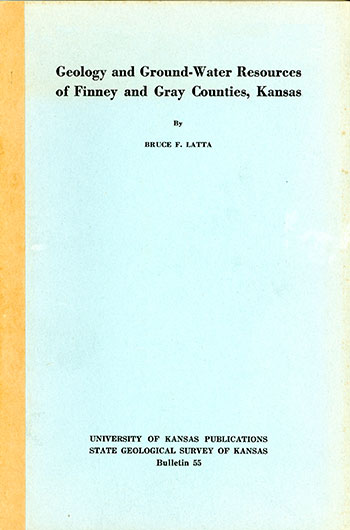Geology and Ground-water Resources of Finney and Gray Counties, Kansas
by Bruce F. Latta
with analyses by E.O. Holmes.

Originally published in 1944 as Kansas Geological Survey Bulletin 55. This is, in general, the original text as published in 1944. The information has not been updated.
You may also wish to visit our web sites on the Finney and Gray county geologic maps.
Abstract
This report describes the geography, geology, and ground-water resources of Finney and Gray counties in southwestern Kansas. Finney and Gray counties have a total area of about 2,160 square miles, and in 1940 had a population of 14,865. The area consists of relatively flat to gently rolling upland plains which are disrupted in places by the valleys of Arkansas and Pawnee rivers and Crooked Creek and by accumulations of wind-blown sand. In the northwestern part of the area is the Finney basin--a broad, shallow, asymmetrical depression extending from the Arkansas valley northward into Scott County. The climate is sub-humid to semiarid, the average annual precipitation being about 21 inches. Farming and some cattle raising are the principal occupations in the area. Irrigation is practiced extensively in the Arkansas valley and in some parts of the uplands.
The exposed rocks are sedimentary and range in age from Upper Cretaceous to Recent. A map showing the areas where the different rock formations crop out is included with the report. Most of the area is underlain by permeable Quaternary and Tertiary sands and gravels, much of which is saturated and yields relatively large quantities of water to wells. In the northeastern or "panhandle" part of Finney County, Pawnee River has cut below the Tertiary sediments and exposed Cretaceous shales and limestones (Niobrara formation and Carlile shale), which locally yield meager quantities of water to wells.
The report contains a map of the area showing by means of shading the depth of water level. The water table ranges in depth from less than 5 feet in parts of the Arkansas valley to about 200 feet on the uplands south of the valley in eastern Gray County. A map showing by means of contours the shape and slope of the water table is also included with the report. This map shows that ground water moves through Finney and Gray counties in a general easterly direction. The gradient of the water table ranges from about 3 feet to the mile in the Finney basin to as much as 35 or 40 feet to the mile in northwestern Finney County. The map also shows that ground water moves into the Arkansas valley from both sides and that slight ground water divides exist both north and south of the Arkansas valley throughout most of its course in this area.
The ground-water reservoir is recharged principally by precipitation that falls within the area, by the addition of water from Arkansas River in the Western part of the area, and by ground water moving in from adjacent areas. Ground water is discharged from the ground-water reservoir mainly by movement eastward and southeastward into adjacent areas, by evaporation and transpiration in areas of shallow water table, by seepage into Arkansas River, and by wells. Some water is discharged by springs and seeps along Pawnee River and its tributaries. All of the domestic, stock, public, and industrial water supplies and a part of the irrigation water supplies are obtained from wells.
Most of the wells in the area are drilled, but some are dug, driven, or bored. Of the 244 irrigation-well pumping plants visited in the area in 1940, 183 were in the Arkansas valley and 61 were on the uplands either north or south of the valley. In 1939, they supplied about 32,000 acre-feet of water to irrigate approximately 21,860 acres (includes land irrigated by surface water and by a supplementary supply of ground water). The most favorable areas for future irrigation development are parts of the Arkansas valley, the Finney basin: and the uplands in west-central Gray County.
The ground water in Finney and Gray counties, although generally hard, is suitable for most ordinary uses. The waters from the Pliocene (Ogallala formation) and undifferentiated Pleistocene deposits and terrace gravels are similar in composition and hardness. Waters from the alluvium generally are very hard. Waters from the Dakota formation are relatively soft, and are believed to have been softened naturally by a base-exchange process.
The principal water-bearing formations in this area are alluvium and the Pliocene (Ogallala formation) and undifferentiated Pleistocene deposits. A few wells obtain water from the Dakota formation, Carlile shale, Niobrara formation, and the terrace gravels. The character and water supply of each formation are discussed in the report.
The field data upon which most of this report is based are given in tables, and include records of 543 wells and springs, and chemical analyses of the water from 55 representative wells. Logs of 60 test holes, water wells, and oil and gas wells in the area are given, including 29 test holes put down by the State and Federal Geological Surveys.
Kansas Geological Survey, Geology
Web version April 2002. Original publication date Dec. 1944.
Comments to webadmin@kgs.ku.edu
The URL for this page is http://www.kgs.ku.edu/General/Geology/Finney/index.html